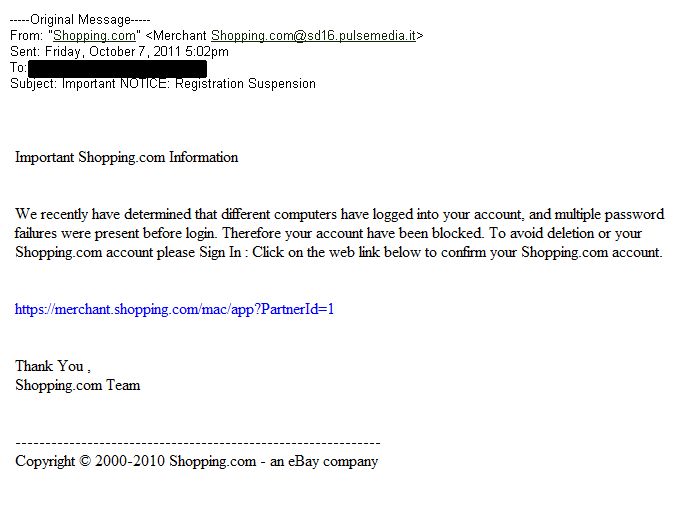Identifying An Email “Phishing” Scam

By Vanessa Salvia
“Phishing” is a term for an unsolicited email from what appears to be a legitimate,
reputable company. The phishing email asks for some kind of sensitive information,
typically account log-in info or financial or banking info. The email may warn that the
recipient’s accounts will be terminated unless they log in and update their credit card
information, for instance. Or the message offers a service to protect their credit cards from
possible fraud, but they have to click on a web link to log in or supply some other sensitive
info. The emails then deceptively send the user to a fake site and collect whatever
information the user enters.
This scam has been around nearly as long as the Internet has been in existence, but
phishers have gotten increasingly more sophisticated and deceptive with their tactics. At
first glance, everything about the email looks legitimate, and that’s intentional.
If an email is designed to look like it originated from a particular bank, the scammers will
use the same colors, layout, and wording as the legitimate bank. But if you know what to
look for, there are clues that can reveal these scammers before you get taken advantage
of.
A customer of ours recently received an email claiming to be from Shopping.com. Let’s
take a look at an image of the email that was received:
The “from address” looks at first glance like it comes from Shopping.com. The email says
the account was compromised by different computers and multiple password attempts
being used to access the account. The email warns of dire consequences—the
Shopping.com account will be deleted—unless the recipient signs in using the provided
web link to confirm the account. It looks legitimate. But the web link included in the
message sends the user to a fake Shopping.com site where personal information is
captured from the unsuspecting individual.
What Can You Look For?
Check the “From” Email Address
In this case, the actual email address is Shopping.com@sd16.pulsemedia.it. The internet
address part of this email is based in Italy. It is unlikely that a business contacting
customers in the United States would use an Internet site registered in a foreign country.
Spelling and Grammar
In this case, the sentence: “To avoid deletion or your Shopping.com account please Sign
In.” contains a typo. It should read, “To avoid deletion of your Shopping.com account . . .”
Of course, it is possible for the person composing an email to make a simple mistake like
that, one that a spellchecker wouldn’t catch, but it is unlikely to be coming from such a huge
and professionally managed enterprise as Shopping.com.
Threats
It’s a common tactic of cybercriminals to give you a sense of urgency--if you don’t take
action right now by doing whatever the email says to do, then you will lose something
important. Don’t fall for it. If there is any doubt in your mind, contact the company via their
official customer service channels and ask them if there is a problem with your account.
Look at the Link
If you see a link in a suspicious email message, don't click on it. Rest your mouse (but don't
click) on the link to see if the address matches the link that was typed in the message.
Take a look at this screen shot of what the link looks like when the mouse is just hovering
over it (not clicking it):

reputable company. The phishing email asks for some kind of sensitive information,
typically account log-in info or financial or banking info. The email may warn that the
recipient’s accounts will be terminated unless they log in and update their credit card
information, for instance. Or the message offers a service to protect their credit cards from
possible fraud, but they have to click on a web link to log in or supply some other sensitive
info. The emails then deceptively send the user to a fake site and collect whatever
information the user enters.
This scam has been around nearly as long as the Internet has been in existence, but
phishers have gotten increasingly more sophisticated and deceptive with their tactics. At
first glance, everything about the email looks legitimate, and that’s intentional.
If an email is designed to look like it originated from a particular bank, the scammers will
use the same colors, layout, and wording as the legitimate bank. But if you know what to
look for, there are clues that can reveal these scammers before you get taken advantage
of.
A customer of ours recently received an email claiming to be from Shopping.com. Let’s
take a look at an image of the email that was received:

The “from address” looks at first glance like it comes from Shopping.com. The email says
the account was compromised by different computers and multiple password attempts
being used to access the account. The email warns of dire consequences—the
Shopping.com account will be deleted—unless the recipient signs in using the provided
web link to confirm the account. It looks legitimate. But the web link included in the
message sends the user to a fake Shopping.com site where personal information is
captured from the unsuspecting individual.
What Can You Look For?
Check the “From” Email Address
In this case, the actual email address is Shopping.com@sd16.pulsemedia.it. The internet
address part of this email is based in Italy. It is unlikely that a business contacting
customers in the United States would use an Internet site registered in a foreign country.
Spelling and Grammar
In this case, the sentence: “To avoid deletion or your Shopping.com account please Sign
In.” contains a typo. It should read, “To avoid deletion of your Shopping.com account . . .”
Of course, it is possible for the person composing an email to make a simple mistake like
that, one that a spellchecker wouldn’t catch, but it is unlikely to be coming from such a huge
and professionally managed enterprise as Shopping.com.
Threats
It’s a common tactic of cybercriminals to give you a sense of urgency--if you don’t take
action right now by doing whatever the email says to do, then you will lose something
important. Don’t fall for it. If there is any doubt in your mind, contact the company via their
official customer service channels and ask them if there is a problem with your account.
Look at the Link
If you see a link in a suspicious email message, don't click on it. Rest your mouse (but don't
click) on the link to see if the address matches the link that was typed in the message.
Take a look at this screen shot of what the link looks like when the mouse is just hovering
over it (not clicking it):

Hovering over the link reveals the real web address, that looks nothing like the web
address the email gives.
Who Is It From?
A scam won’t work unless you trust the company that the email is supposedly from. If the
email is from a company you do business with, such as eBay, Facebook, PayPal,
Shopping.com, Amazon, your mortgage company, or your bank, automatically be
suspicious. Again, if there is any doubt, contact the company directly and ask.
If You Do Click . . .
If you click on a link in a scam e-mail, be prepared to be a victim of identity theft. That is
harsh advice but unfortunately true. Place fraud alerts on your credit reports, from all three
credit report companies. If you provided bank info, contact the bank and close the
accounts.
If you go to a link offered in an unsolicited e-mail, check to see if there is an 's' after the http
in the address and a lock at the bottom of the screen that indicates the link is secure and
encrypts the information. Though this is not an indication that the site is legitimate, an
online form that asks a consumer to submit sensitive personal information should always
be encrypted.
Don’t Give Out Any Personal Information
Verify the legitimacy of a web address with the company directly before submitting your
personal information over an email.
Assume that a legitimate company will not ask you for personal information in an email.
(They don’t, and they won’t.) Bottom line: protect yourself by not “biting” on these “phishy” emails.
address the email gives.
Who Is It From?
A scam won’t work unless you trust the company that the email is supposedly from. If the
email is from a company you do business with, such as eBay, Facebook, PayPal,
Shopping.com, Amazon, your mortgage company, or your bank, automatically be
suspicious. Again, if there is any doubt, contact the company directly and ask.
If You Do Click . . .
If you click on a link in a scam e-mail, be prepared to be a victim of identity theft. That is
harsh advice but unfortunately true. Place fraud alerts on your credit reports, from all three
credit report companies. If you provided bank info, contact the bank and close the
accounts.
If you go to a link offered in an unsolicited e-mail, check to see if there is an 's' after the http
in the address and a lock at the bottom of the screen that indicates the link is secure and
encrypts the information. Though this is not an indication that the site is legitimate, an
online form that asks a consumer to submit sensitive personal information should always
be encrypted.
Don’t Give Out Any Personal Information
Verify the legitimacy of a web address with the company directly before submitting your
personal information over an email.
Assume that a legitimate company will not ask you for personal information in an email.
(They don’t, and they won’t.) Bottom line: protect yourself by not “biting” on these “phishy” emails.

